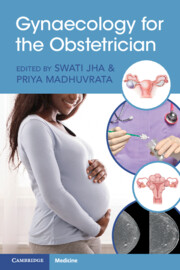Book contents
- Gynaecology for the Obstetrician
- Gynaecology for the Obstetrician
- Copyright page
- Dedication
- Contents
- Contributors
- Foreword
- Preface
- Chapter 1 Ovarian Cysts in Pregnancy
- Chapter 2 Fibroids in Pregnancy
- Chapter 3 Cervical Abnormalities in Pregnancy
- Chapter 4 Vulval Disorders in Pregnancy
- Chapter 5 Congenital Uterine Malformations and Vaginal Anomalies
- Chapter 6 Vaginal Prolapse and Previous Prolapse Surgery
- Chapter 7 Urinary Tract Problems in Pregnancy
- Chapter 8 Previous Third and Fourth Degree Tears
- Chapter 9 Management of Post-Partum Retained Placental Remnants
- Chapter 10 Gestational Trophoblastic Disease (GTD)
- Chapter 11 Female Genital Mutilation
- Chapter 12 Ovarian and Cervical Malignancy in Pregnancy
- Chapter 13 Post-Partum Contraception
- Chapter 14 Pregnancy Associated Breast Cancer
- Index
- References
Chapter 10 - Gestational Trophoblastic Disease (GTD)
Published online by Cambridge University Press: 14 July 2023
- Gynaecology for the Obstetrician
- Gynaecology for the Obstetrician
- Copyright page
- Dedication
- Contents
- Contributors
- Foreword
- Preface
- Chapter 1 Ovarian Cysts in Pregnancy
- Chapter 2 Fibroids in Pregnancy
- Chapter 3 Cervical Abnormalities in Pregnancy
- Chapter 4 Vulval Disorders in Pregnancy
- Chapter 5 Congenital Uterine Malformations and Vaginal Anomalies
- Chapter 6 Vaginal Prolapse and Previous Prolapse Surgery
- Chapter 7 Urinary Tract Problems in Pregnancy
- Chapter 8 Previous Third and Fourth Degree Tears
- Chapter 9 Management of Post-Partum Retained Placental Remnants
- Chapter 10 Gestational Trophoblastic Disease (GTD)
- Chapter 11 Female Genital Mutilation
- Chapter 12 Ovarian and Cervical Malignancy in Pregnancy
- Chapter 13 Post-Partum Contraception
- Chapter 14 Pregnancy Associated Breast Cancer
- Index
- References
Summary
Gestational trophoblastic disease (GTD) incorporates a spectrum of placental related disorders, with both benign and malignant (Gestational trophoblastic neoplasia (GTN)) subtypes. Upon initial presentation, one should establish diagnosis (GTD versus GTN), the requirement for chemotherapy and whether monitoring has been concluded by a specialist trophoblastic centre. Women with a prior history of GTD or GTN that have completed monitoring, or early pregnant GTD patients, do not require specialist pregnancy management. Dissimilarly, early pregnant GTN patients, particularly those treated for high-risk disease, or women with a twin pregnancy involving a complete hydatidiform mole and viable co-existent foetus should receive detailed antenatal counselling and be managed under consultant-led care. Patients with a twin mole and viable co-existent foetus have a high risk of antenatal, intrapartum and post-partum complications. Fortunately, in women with a prior history of trophoblastic disease, live birth rates equal the general population, with no increased risk of disease relapse.
Keywords
- Type
- Chapter
- Information
- Gynaecology for the Obstetrician , pp. 95 - 108Publisher: Cambridge University PressPrint publication year: 2023



